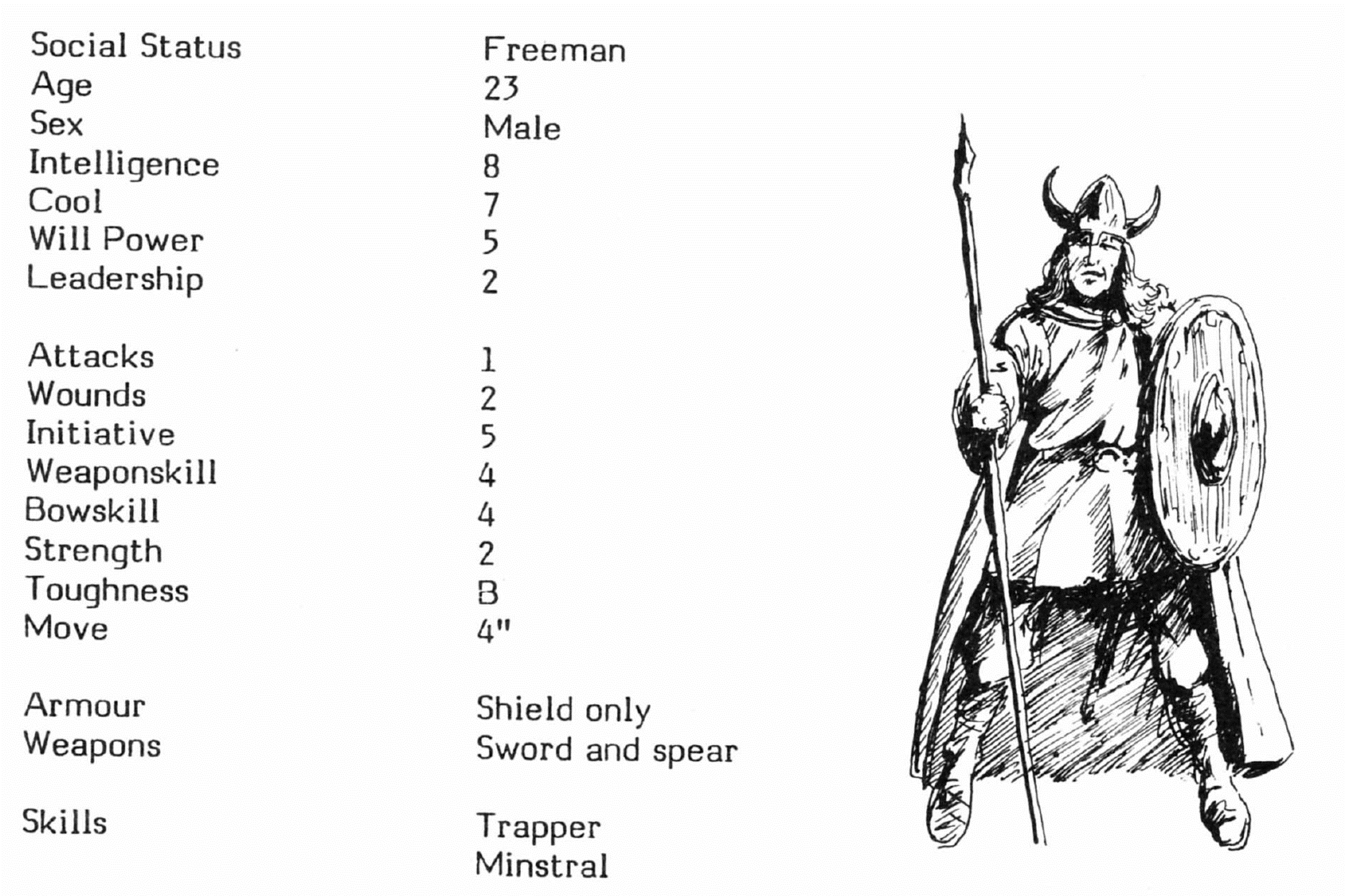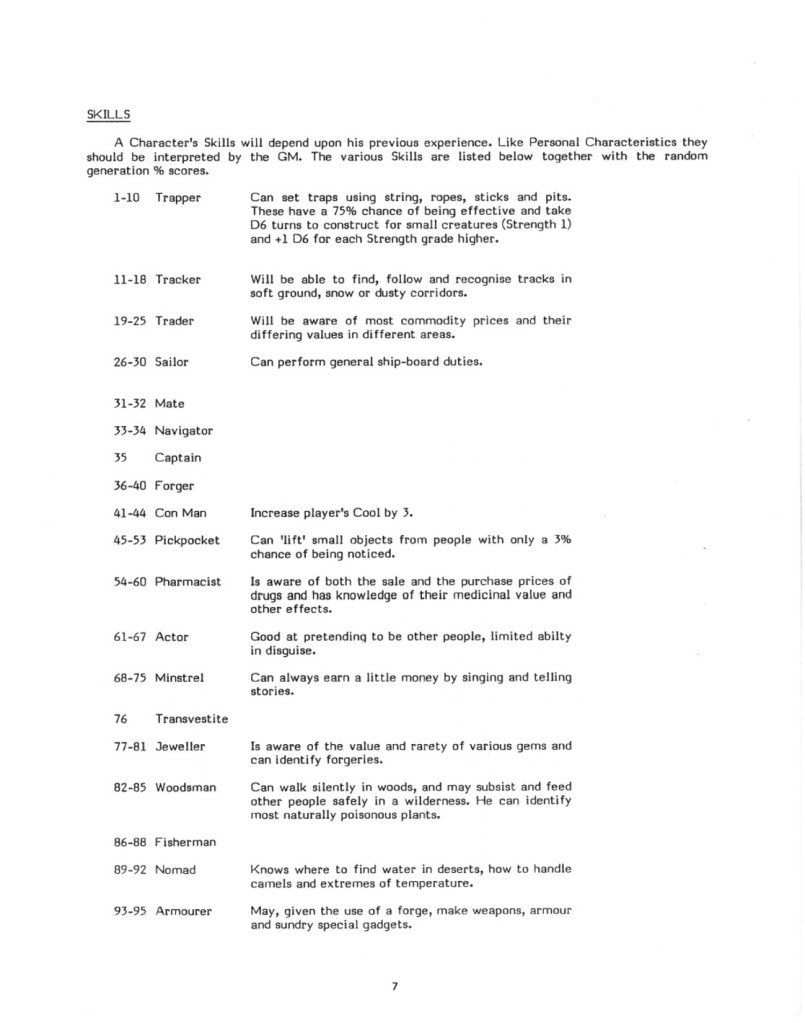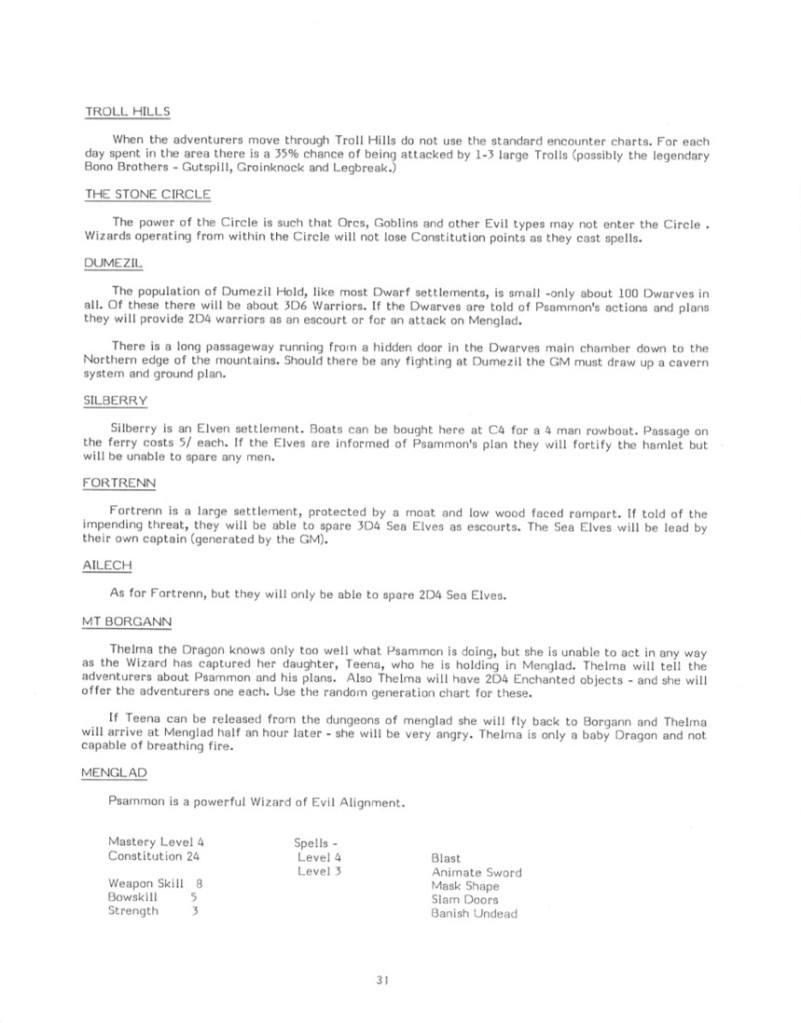This post continues my history of WFRP1, which started here.
As discussed in my last post, WFB1 styled itself as a “dual system” for both wargaming and role-playing. It was therefore the first role-playing system for the Warhammer world and WFRP1’s immediate forerunner. In truth WFB1’s claims to be a role-playing game are somewhat stretched. The basics of character generation and advancement are described, but the account is brief and lacking in many of the features that were even in 1983 considered standard in RPGs. Nonetheless, some elements of WFRP can already be seen emerging.
CHARACTERS
Characters may be one of three races (human, dwarf or elf). They are described by a familiar profile, which includes Move, Weaponskill, Bowskill, Strength Grade, Toughness, Wounds to Kill, Initiative, Number of Attacks, Leadership, Intelligence, Cool and Will Power. (There is no system for abbreviating these characteristics in WFB1.) These characteristics are all expressed on the same scale as the wargaming rules. Characters are also are described by age, gender, social status and skills. Nearly everything is determined randomly, even race.
Given how basic much of the role-playing system is in WFB1, the inclusion of a social status mechanic might seem suprising. However, its use is confined to generating a character’s starting wealth.

The first character sheet
SKILLS, CAREERS AND ADVANCEMENT
The role-playing rules include a set of twenty-two one-off skills. They are only briefly and vaguely described and their role is largely left at the GM’s discretion. It is easy to see them as the origin of WFRP’s one-off skill system. However, I believe their significance goes beyond that. WFB1’s skills are an inchoate careers system.
They may not be called “careers”, but they look very like them. They are named like careers. They describe not a narrowly defined ability, but a broad set of talents. They cannot be learned, but “depend on a character’s previous experience”. Eighteen of the twenty-two actually reappear as careers in WFRP1. Remarkably there is even a short downtime system (WFB1, ‘Characters’, pp19-20) where characters with the requisite skills can earn a living through employment when not adventuring.

Comparison of skills in WFB1 and careers in WFRP1
In short, WFB1‘s skills function in the same way as starting careers in WFRP1. They describe characters’ experience prior to becoming adventurers. Unlike WFRP1, though, WFB1 characters could have multiple past careers at initiation.


Skills or careers?
Skills have no role in character advancement. Once a character becomes an adventurer, a different set of mechanics are used, and it is in these that we find the first explicit reference to “careers” in Warhammer. Characters are offered one of two adventuring career paths, Fighter or Wizard. These career paths function like WFRP1‘s adventuring careers. They are, of course, vastly more limited than those in WFRP1: there are only two careers and there is no way to move between them. However, WFB1‘s simple system does at least avoid the problems WFRP1 suffers in combining adventures and careers in the same narrative.
Within the Fighter and Wizard career paths characters can advance according to a system that resembles Laserburn‘s (see part III). Experience points are used to advance certain characteristics (Initiative, Weaponskill, Bowskill, Wounds and Attacks). In the case of wizards they can also be used to increase Constitution Points, learn new spells or advance Mastery level. Experience points are earned for killing creatures and collecting gold, as in D&D, but also for “surviving adventures and accomplishing missions”. Experience points are, again as in D&D, accumulated, not spent, and the rate of advancement is non-linear.
There are some traces of WFRP‘s later skills in the magic rules, which grant wizards certain “innate abilities”. These are not described as skills, but some of them would become skills in WFRP1. They include Magical Sense and Trance of Magical Awareness, which are both described in terms very similar to their WFRP1 counterparts. In fact, the only significant difference is that in WFB1 a Trance of Magical Awareness requires the wizard to spend a Constitution Point each round, but leaves him or her free to move and act during the trance.
SCENARIO
WFB1’s ‘Characters’ book contains a short role-playing scenario called ‘The Redwake River Valley’. It is the first Warhammer role-playing adventure to be published, predating ‘The Web of Eldaw’ (see part XXXVII) by two years and ‘The Oldenhaller Contract’ by three. It is a traditional mix of wilderness and dungeon. A formerly good wizard has turned to evil and is secretly amassing a goblinoid army, with which he intends to take over the region. If the plot sounds familiar, that is unsurprising. It appears to be based heavily on The Lord of the Rings. The setting of the wizard’s tower bears a marked resemblance to Isengard. Even the wizard’s name, Psammon, closely echoes his counterpart in Tolkien. There is also the first Warhammer pun: the wizard’s sword is called Psammonella.









The Redwake River Valley
(Download as PDF)
OVERALL
WFB1‘s ambition to be a dual system for wargames and role-playing is in my opinion largely unfulfilled. While the wargame rules are solid, the role-playing system falls far short of the standards set by contemporaries. Yet it is interesting, at least, that the attempt was made to address both hobbies. It perhaps reflects a view at the time that RPGs were important to buyers of miniatures. Regrettably that view would not survive for long.
The next post will look at the first incarnation of the Warhammer world.
CHRONOLOGY
The following chart summarises the chronology of this post relative to others in this section of ‘The WFRP Story’.

Title art by Chris Achilleos. Used without permission. No challenge intended to the rights holders.
The most interesting part of the roleplaying part of WFB1 was, it seems to me, the fact that ideas about social position and career experience were there in the very first attempt. You are right that the skills system actually provides something of a proto-careers based way of dealing with characters. Whilst the social status has a very limited role mechanically, the way in which it is randomly generated and provides for a wide range of backgrounds also hints at the way the career system of WFRP would randomly generate background and, by default, social position for characters.
These ideas obviously remained strongly in the mix for the developing system and the WD article dealing with types thieves suggests that the ideas about careers were at the heart of what was developing into WFRP.
LikeLiked by 1 person
I quite agree, and you make a good point about social status. The social and career elements of WFB1 read to me like a list of ideas that there wasn’t time to develop. The thieves article is a particularly interesting insight into how the ideas did subsequently evolve, but I’ll come to that later….
LikeLike